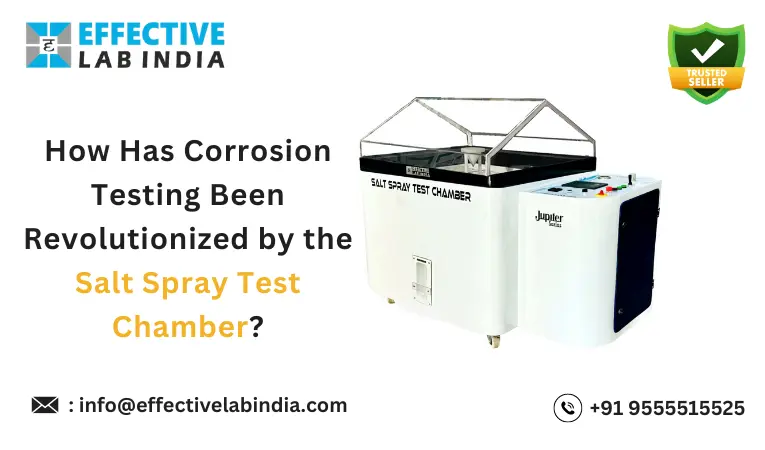Metals are utilized in a range of products, which increases the efficiency of the manufacturing process. To determine whether these materials are best suited for use in various environmental settings becomes very important. This determination guarantees the long-term functionality and smoothness of the finished product. As a result, assessing the resistance to corrosion of these materials becomes essential.
A cutting-edge lab testing instrument manufactured by Effective Lab India assesses the ability of metals to resist rust. As a result, the manufacturer can achieve optimal customer satisfaction by offering perfectly tested products and building a strong brand name. The salt spray chamber is a cutting-edge laboratory testing device which is the outcome of exceptional engineering, great hard working and a commitment to producing high-quality final goods by identifying uncertainties at the initial stage. Let’s take a look at the functioning of this instrument and understand how it helps manufacturers in various industries in assessing the materials’ resistance to corrosion.
Working of Salt Spray Chamber
The functionality of this lab testing instrument, which guarantees precision and consistency along with cutting-edge features, makes it useful in many industries. The apparatus can be divided into four main categories.
1. The interior compartment
2. Tank reservoir
3. Saturator of air
4. Panel for electricity
The specimen must be placed inside the inner chamber by the operator before starting the salt spray test procedure. Three placing locations of samples are available in the inner chamber. These places depend on the operator’s needs and the sample’s size. To prevent any external contact that could contaminate the sample and leave corrosive effects on the exterior, it is crucial to ensure that the specimen is positioned exactly and that the inner chamber canopy is closed when the specimen is put inside. Using an HMI-based touchscreen that is attached to the electrical panel, the operator may easily profile the specimen once it has been placed.
An entrance pipe allows the demineralized water from the reservoir tank, which has been filtered using a layer sponge filter, to mix with salt (NaCl) to generate a solution that is then pumped to the inner chamber. By functioning at 45 degrees Celsius, the air saturator raises the temperature of the air and adds humidity to it. Via an entrance pipe, the humidified air enters the inner chamber. Using an atomizer and an igus coated with a fog dispenser, the salt-water solution from the reservoir tank is distributed throughout the inner chamber together with the humidified air. Using an atomizer and an igus, a concentration of fog is created by the combination of salt water and humidified air, and it is applied evenly throughout the specimen.
The fog is evenly distributed throughout the specimen thanks to the fog dispenser. For long-term testing, the temperature elevation is maintained by the silicon bag heaters built into the inner chamber walls. At this point, manufacturers can measure uncertainties (if any) and eliminate them at this early stage by simply evaluating the tested specimen’s responses to the artificial climate surrounding it. The HMI-based touchscreen on the salt spray test equipment displays the test results, making it simple and smooth to track outcomes and critically analyze previously acquired data.
The operator needs to utilize the air purge once the salt spray test is over, as this helps to disperse the concentrated fog that is caused by high compressors inside the inner chamber, before opening the canopy. This must be done to protect the instruments housed outside from the inner chamber’s corrosion-friendly atmosphere. The salt spray test machine contains a few characteristics that cover the instrument’s flawless operation with complete ease and help the operator execute the test with no difficulty at all.
Features of Salt Spray Machine.
The salt spray test chamber has many safety measures that protect the user and allow it to work with a methodology of accuracy and testing standards. The inner chamber’s sturdy, anti-corrosive, and highly insulated design is by far its most unique characteristic. Glass wool serves as the anchor for a three-layered wall protection system that consists of an MS sheet, an FRP sheet, and glass wool. The use of silicon bag heaters guarantees consistent heating within the inner chamber, optimizing precision even during extended testing. Manufacturers from various sectors trust the lab testing salt spray test chamber because of its 7-alarm feature, which offers a sense of security.
Depending on the needs of the client, the inner chamber of the lab testing apparatus is offered in various sizes. It is crucial to understand that the inner chamber’s size and the reservoir tank’s size are intimately correlated. With the HMI-based touchscreen integrated, the maker can effortlessly profile, record, monitor, and handle all tasks by themselves. To improve overall testing quality, the pricing of the salt spray test machine is provided from a very reasonable standpoint.

